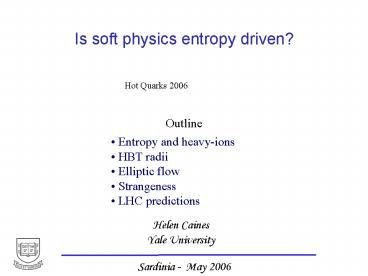Is soft physics entropy driven? PowerPoint PPT Presentation
Title: Is soft physics entropy driven?
1
Is soft physics entropy driven?
Hot Quarks 2006
Outline
- Entropy and heavy-ions
- HBT radii
- Elliptic flow
- Strangeness
- LHC predictions
2
Hagedorn temperature (1965)
- Resonance mass spectrum grows exponentially
- Add energy to system produce more and more
particles - Maximum T for a system of hadrons.
TH 160 MeV
TDS DE
increase vs ? increase S
Blue Exp. fit Tc 158 MeV
r(m) (GeV-1)
Green - 1411 states of 1967 Red 4627 states of
1996
m (GeV)
3
Entropy and energy density
- Landau and Fermi (50s)
- Energy density, e, available for particle
creation - Assume S produced in early stages of collision
- Assume source thermalized and expands
adiabatically - Preserve S
- Ideal fluid
- S correlated to e via EOS
dNch/dh is correlated to S
4
Entropy and vs
- Approximate EOS for that of massless pions.
- Assume blackbody
- s S/V related to e
s
Fn(vs)
5
Nch as measure of entropy
J.Klay Thesis 2001
- Entropy in Heavy Ion
- gt Entropy in p-p?
Different EOS? QGP?
6
Heavy-ion multiplicity scaling with vs
There is a scaling over several orders of
magnitude of v s
i.e. As function of entropy
PHOBOS White Paper Nucl. Phys. A 757, 28
7
HBT radii
No obvious trends as fn of vs
p HBT radii from different systems and at
different energies scale with (dNch/d?)1/3
power 1/3 gives approx. linear scale
Works for different mT ranges
Entropy determines radii
8
Eccentricity and low density limit
v2 different as fn Npart and energy
- At hydro. limit v2 saturates
- At low density limit
Apparent complete failure. Especially at low
density!
Voloshin, Poskanzer PLB 474 (2000) 27
9
Fluctuations matter
PHOBOS QM2005
Important for all Cu-Cu and peripheral Au-Au
10
Now see scaling
Energy range scanned from vs 4-200 GeV
Again dN/dy i.e. entropy important
low density limit scaling now works
11
Strangeness production
Solid STAR Au-Au vsNN 200 GeV Hollow - NA57
Pb-Pb vsNN 17.3 GeV
- G C models
- linear increase with strangeness production
volume - Volume ? Npart
- Increase should decrease with vs
None of the predictions seem correct
STAR Preliminary
12
Strangeness vs entropy
Solid STAR Au-Au vsNN 200 GeV Hollow - NA57
Pb-Pb vsNN 17.3 GeV
dNch/dh npp((1-x)Npart/2 xNbin) npp
Yield in pp 2.29 ( 1.27) x 0.13
No scaling between energies
But does become linear at higher dNch/dh
13
LHC prediction I
6.4 RHICx1.6
Most central events dNch/dh 1200
PHOBOS White Paper Nucl. Phys. A 757, 28
14
LHC prediction II
Most central events dNch/dh 1200 dNch/dh1/3
10.5
Ro Rs Rl 6 fm
15
LHC prediction III
Most central events dNch/dh 1200 S 20
But I suspect Im not in the low density limit
any more so
v2/e 0.2
16
LHC prediction IV
Most central events dNch/dh 1200
03
17
Conclusions
- dNch/dh is strongly correlated with entropy
- dNch/dh scales as log(vs)
- Several variables from the soft sector scale
with dNch/dh - HBT
- v2 at low densities
- Strangeness centrality dependence
Soft physics driven by entropy not Npart
18
Elliptic flow
v2 same for 200 62 GeV Au-Au at fixed pT
v2 decreases by 50 from RHIC to SPS
No perfect scaling but hints
v2 same in Au-Au and Cu-Cu for same centrality
19
Reminder
Entropy S
Classical thermodynamics A measure of the
amount of energy in a physical system that
cannot be used to do work.
Statistical thermodynamics A measure of the
statistical "mixedupness" of the thermodynamic
system The amount of uncertainty that would
remain about the exact microscopic state of the
system, given a description of its macroscopic
properties.
TDS DE
20
HBT radii
No obvious trends as fn of vs
p HBT radii from different systems and at
different energies scale with (dNch/d?)1/3
power 1/3 gives approx. linear scale
Works for different mT ranges
Entropy determines radii
21
Can we describe vs dependence?
PHOBOS Phys. Rev. C70, 021902(R) (2004)
Theres a correlation between dNch/dh and Npart/2
small dotted lines are dNch/dh
npp(1-x)Npart/2 xNbin npp Yield in pp
2.29 ( 1.27) x 0.13
N.B. SPS energy only 17 GeV
If know npp can predict yield at any ?Npart?

